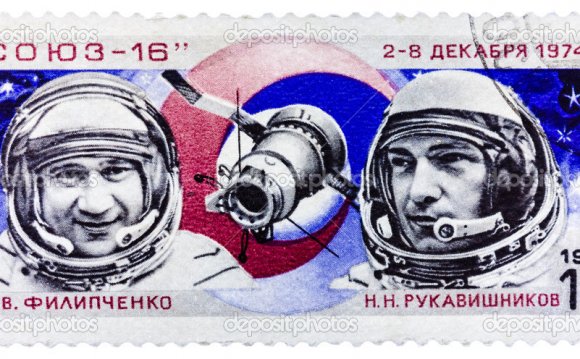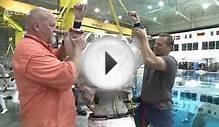
|
Yuri Gagarin At the beginning of 60s nothing more symbolized the USSR's status as a world leader than the beginning of the space age. Between 1957 and 1965 the Soviet Union set one space record after another: the first satellite in orbit; sending space probes to the moon; putting the first man and the first woman in space; keeping a manned spacecraft in orbit for as long as five days; and the first space walk. Yuri Gagarin (1934-1968), flew into orbit aboard the Soviet spacecraft Vostok I on 12 April 1961, becoming the first man in space. He orbited the Earth once (his capsule was controlled from the ground) before returning for a safe landing in the Soviet Union roughly 90 minutes later. |
| Gagarin was a confident, action-oriented young man, neither profound nor convoluted in his thinking, reliable and sturdy in his response to the challenge of the Vostok spacecraft. His image benefits from its eternal youth, since his early death a few years later preserved his fame against growing old. Such a man was needed to step across the frontier where unknown physical and psychological dangers lay in wait.
"It seems to me now that all my life is a one beautiful moment. All that I have been through, all that has been done was for this minute's sake, " - Yuri Gagarin. |
| he 1961 flight made him an international hero; While on board, received a word that he had been promoted to the rank of major. He was also awarded the Order of Lenin and made a deputy of the Soviet parliament, the Supreme Soviet. The flight was also considered a political victory for the Soviet Union; the United States didn't put a man into space until Alan Shepard's sub-orbital flight on 5 May 1961.
Gagarin was preceded into space by a Soviet dog, Laika. |
| Gagarin was born in the Smolensk region of the former USSR. His family was displaced during World War II and moved to the town of Gzhatsk in the northeastern part of Smolensk. In 1949 Gagarin began his higher education at a manufacturing trade school in Lyubertsy, a town outside of Moscow. In 1951 he trained as a metalworker at the industrial technical school in Saratov, which is southeast of Moscow. While he was in Saratov, he joined a flying club and learned to fly airplanes. His instructor recommended him to the air force, and Gagarin began attending the Soviet Air Force cadet training school at Chkalov (now Orenburg) in Russia in 1955. He graduated from the academy with high distinction in 1957, shortly after the launch of Sputnik 1. |
|
agarin applied for the six-week cosmonaut screening process in 1960 with just 230 hours of flying experience. He and 19 others were selected to become cosmonauts. Of these 20 men, 12 eventually completed space flights. Gagarin and fellow cosmonaut Gherman Titov, front-runners in their class, were both contenders for the Vostok 1 flight. Gagarin was chosen to fly aboard Vostok 1 just four days before the launch date. There was at least one delay in the countdown, due to a faulty valve. At 9:07 am, Vostok 1, using the radio name CEDAR, lifted off for its 108-minute flight. |
| Gagarin was exposed to about six times the normal force of gravity on the earth during the launch phase and about eight times the normal force of gravity during the re-entry.
uring his one orbit around the earth, he ate and drank (no one had ever done this in weightlessness before), monitored the capsules systems, and evaluated his ability to observe features on the earth (he had no camera). The capsules control panels were locked, since everything was either automated or controlled from the ground, but Gagarin had the code to unlock the controls in a sealed envelope in case there was an emergency. Vostok 1 landed in a field near Saratov, observed only by cows and a few peasants. Information that emerged in the late 1980s about the Soviet space program suggests that Gagarin actually bailed out of Vostok 1 at an altitude of about 6 km (about 4 mi) and descended under a parachute separately from the capsule. |
| After his famous flight he remained in the cosmonaut corps. He died at the age of 34 on a routine jet proficiency flight in March 1968.
He had a wife, Valentina Gagarin, and two daughters, Elena and Galya. On April 12, 2001, Gagarin's daughter Elena, was appointed general director of the Moscow Kremlin museum-reservation. |
| agarins ashes were interred in the Kremlin wall. He and his historical flight are remembered officially in many ways. A titanium obelisk, which reaches a height of 40 m (120 ft), was erected at the Vostok 1 landing site. The town of Gzhatsk was renamed Gagarin. A crater on the far side of the moon is named for Gagarin. Also, the main center for cosmonaut training at Star City, Russia, is called the Gagarin Cosmonaut Training Center. |
RELATED VIDEO












